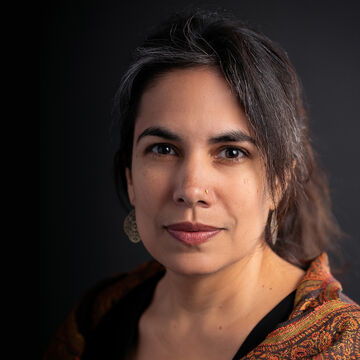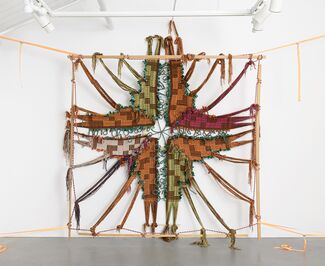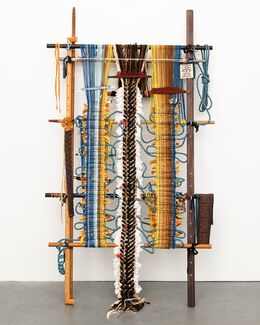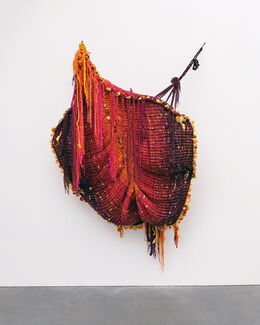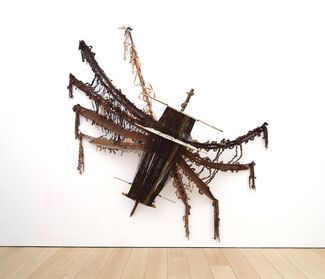| Advanced Woven Structures: Hand and Digital |
Fiber and Material Studies |
3002 (001) |
Fall 2025 |
|
Description
This intensive studio course will focus on weaving and its relation to the evolving landscapes of contemporary art, cultural production, and identity. Working with multi-harness floor looms, students will engage rigorous conceptual questions in abstraction, figuration, sculptural form, spatial intervention, performative action, technology, and language to develop a mature body of woven work. Vocabulary will be expanded through the study of complex woven constructions, digital drafting, and dye processes. Feminist, queer, and decolonial approaches to weaving will be introduced and encouraged. Designed for advanced students, this course engenders an interdisciplinary weaving practice by blurring the boundaries between fiber, critical craft, painting, material culture, sculpture, textile history, architecture, and technology studies.
Students will consider the history and the future of the field through a varying roster of artists including significant figures such as Sheila Hicks, Lenore Tawney, Magdalena Abakanowicz, and Olga de Amaral alongside contemporary generations such as Sonya Clark, Miguel Arzabe, Diedrick Brackens, Erin M. Riley, Josh Faught, Samantha Bittman, and Cecilia Vicuña. This work will be supported by texts that typically include Anni Albers, Legacy Russel, T'ai Smith, Julia Bryan-Wilson, and César Paternosto.
Critical discussion of core texts and individualized research will occur in tandem with weekly studio activity. Students will produce a series of studies and 2 - 4 fully realized woven works that will be developed through in-process discussions and presented in major critique settings.
|
Class Number
1462
Credits
3
|
| Advanced Woven Structure |
Fiber and Material Studies |
4003 (001) |
Fall 2025 |
|
Description
This intensive studio course will focus on weaving and its relation to the evolving landscapes of contemporary art, cultural production, and identity. Working with multi-harness floor looms, students will engage rigorous conceptual questions in abstraction, figuration, sculptural form, spatial intervention, performative action, technology, and language to develop a mature body of woven work. Vocabulary will be expanded through the study of complex woven constructions, digital drafting, and dye processes. Feminist, queer, and decolonial approaches to weaving will be introduced and encouraged. Designed for advanced students, this course engenders an interdisciplinary weaving practice by blurring the boundaries between fiber, critical craft, painting, material culture, sculpture, textile history, architecture, and technology studies.
Students will consider the history and the future of the field through a varying roster of artists including significant figures such as Sheila Hicks, Lenore Tawney, Magdalena Abakanowicz, and Olga de Amaral alongside contemporary generations such as Sonya Clark, Miguel Arzabe, Diedrick Brackens, Erin M. Riley, Josh Faught, Samantha Bittman, and Cecilia Vicuña. This work will be supported by texts that typically include Anni Albers, Legacy Russel, T'ai Smith, Julia Bryan-Wilson, and César Paternosto.
Critical discussion of core texts and individualized research will occur in tandem with weekly studio activity. Students will produce a series of studies and 2 - 4 fully realized woven works that will be developed through in-process discussions and presented in major critique settings. This course facilitates self-directed investigation of concept and technique in hand weaving.
|
Class Number
1447
Credits
3
|
| Advanced Woven Structure |
Fiber and Material Studies |
4003 (001) |
Spring 2026 |
|
Description
This intensive studio course will focus on weaving and its relation to the evolving landscapes of contemporary art, cultural production, and identity. Working with multi-harness floor looms, students will engage rigorous conceptual questions in abstraction, figuration, sculptural form, spatial intervention, performative action, technology, and language to develop a mature body of woven work. Vocabulary will be expanded through the study of complex woven constructions, digital drafting, and dye processes. Feminist, queer, and decolonial approaches to weaving will be introduced and encouraged. Designed for advanced students, this course engenders an interdisciplinary weaving practice by blurring the boundaries between fiber, critical craft, painting, material culture, sculpture, textile history, architecture, and technology studies.
Students will consider the history and the future of the field through a varying roster of artists including significant figures such as Sheila Hicks, Lenore Tawney, Magdalena Abakanowicz, and Olga de Amaral alongside contemporary generations such as Sonya Clark, Miguel Arzabe, Diedrick Brackens, Erin M. Riley, Josh Faught, Samantha Bittman, and Cecilia Vicuña. This work will be supported by texts that typically include Anni Albers, Legacy Russel, T'ai Smith, Julia Bryan-Wilson, and César Paternosto.
Critical discussion of core texts and individualized research will occur in tandem with weekly studio activity. Students will produce a series of studies and 2 - 4 fully realized woven works that will be developed through in-process discussions and presented in major critique settings. This course facilitates self-directed investigation of concept and technique in hand weaving.
|
Class Number
1402
Credits
3
|
| Advanced Fiber and Material Studies Studio |
Fiber and Material Studies |
4005 (001) |
Fall 2025 |
|
Description
This course provides an interdisciplinary forum for in-depth critiques and exploration of students' individual directions within the context of contemporary art. This is a team-taught class and will utilize both instructors for critiques and group activities. Emphasis is on individual studio practice and the development of a more cohesive body of work within a faculty mentorship and peer-to-peer learning structure. Technical and conceptual input will be provided on a tutorial basis. Group discussions, readings, field trips to current exhibitions, and visiting lecturers augment this class. Professional practices will focus on the creation and display of discrete objects and/or installation work for the BFA Exhibition, supported by developing or refining a professional resume and an artist statement. Documentation of individual work for inclusion on the Fiber & Material Studies web page is also required. The print, dye, sewing, and mixed media facilities of the department are available to enrolled students to use. This class is for a minimum of 6 credit hours and is held weekly over a two-day period on Tuesdays and Thursdays. Open to Juniors and Seniors with instructor permission and signature. Course work varies but typically includes the production of major studio projects for critique, student presentations, professional development assignments, documentation of work, and the installation of work in the class display case and an open studio event.
|
Class Number
1448
Credits
6
|
| FIBER: Adv Fiber & Mat Studies Studio |
Fiber and Material Studies |
4908 (001) |
Fall 2025 |
|
Description
This course provides an interdisciplinary forum for in-depth critiques and exploration of students' individual directions within the context of contemporary art. This is a team-taught class and will utilize both instructors for critiques and group activities. Emphasis is on individual studio practice and the development of a more cohesive body of work within a faculty mentorship and peer-to-peer learning structure. Technical and conceptual input will be provided on a tutorial basis. Group discussions, readings, field trips to current exhibitions, and visiting lecturers augment this class. Professional practices will focus on the creation and display of discrete objects and/or installation work for the BFA Exhibition, supported by developing or refining a professional resume and an artist statement. Documentation of individual work for inclusion on the Fiber & Material Studies web page is also required. The print, dye, sewing, and mixed media facilities of the department are available to enrolled students to use. This class is for a minimum of 6 credit hours and is held weekly over a two-day period on Tuesdays and Thursdays. Open to Juniors and Seniors with instructor permission and signature.
Course work varies but typically includes the production of major studio projects for critique, student presentations, professional development assignments, documentation of work, and the installation of work in the class display case and an open studio event.
|
Class Number
1458
Credits
6
|

